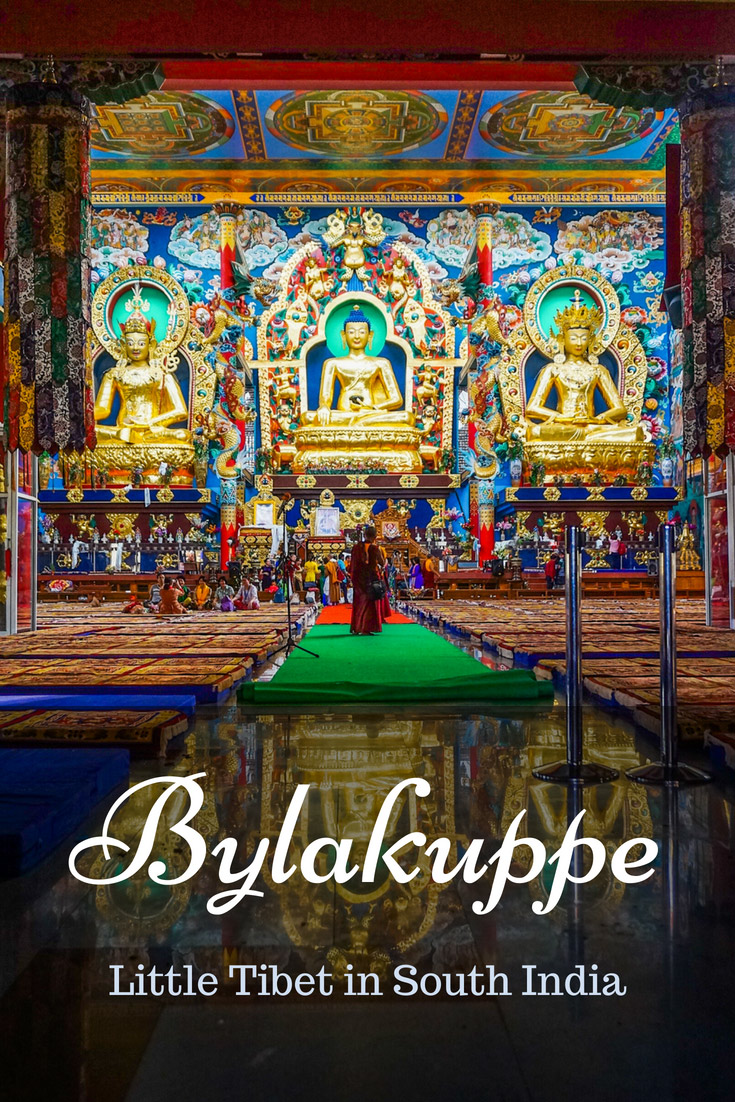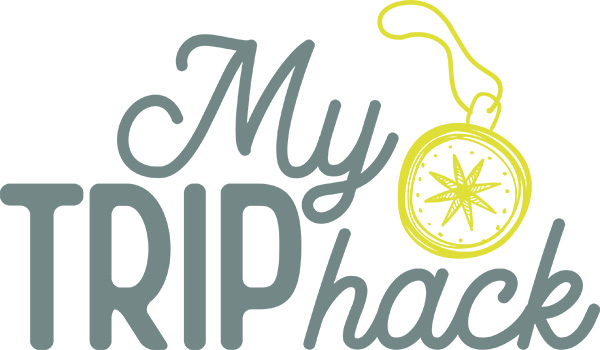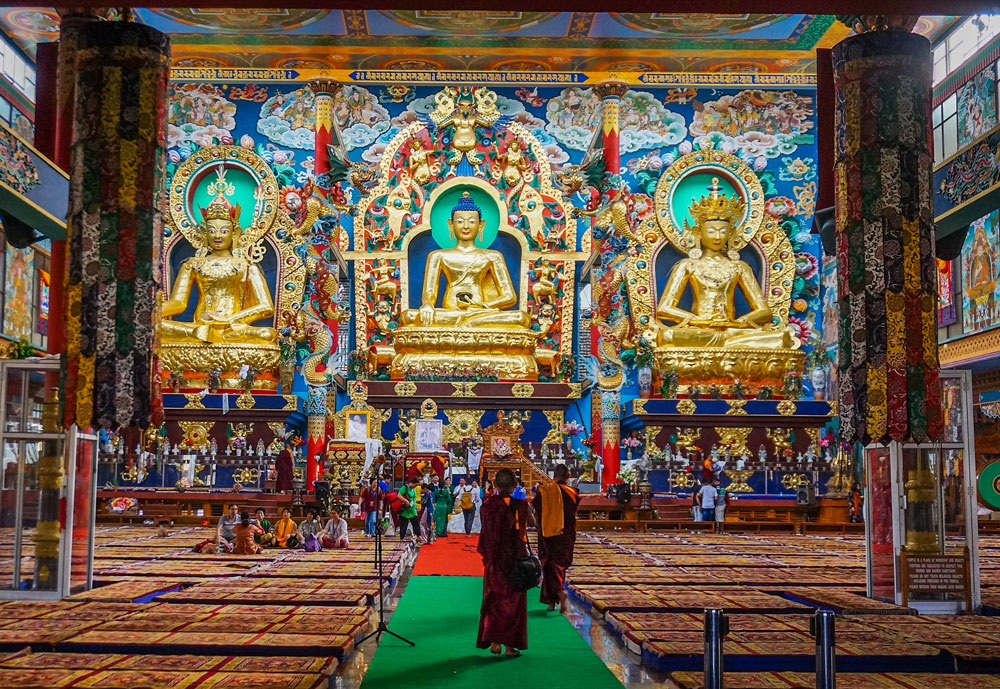Many people associate all Tibetan with Himalaya, mountains, snowy peaks. If you are remotely interested in Tibetan culture, most probably you’ve heard of Dharamshala – the biggest Tibetan settlement in India, where Tibetan government resides. Nevertheless, there is another small town in India which is important in Tibetan culture, yet people rarely talk about it.
Bylakuppe – the second largest Tibetan community in India which is in Karnataka. If you come through national highway you will see a gradual change in scenery, the prayer flags starting a few kilometers before the town and different architectural style.
Bylakuppe town is mainly famous for Namdroling Monastery which is known as Golden Temple of South India. Nevertheless, there are also several other places of interest that give more insight into Tibetan culture.
In this post, I will share with you more information about the town, how to reach it, places to visit in Bylakuppe and other details to help you plan your trip.
Namdroling Monastery – Golden Temple in Karnataka

Right from the entrance to the complex, the colorful murals, big prayer flags, the intricate architecture will capture your attention. This temple stands out with its fascinating interiors. There are three 40 feet tall golden color statues – Buddha, Padmasambhava and Amitayus, colorful wood carvings and mural paintings on the ceiling. You can spend hours looking at the intricate details of the temple interiors and listening to the silence in the off-season when there are fewer visitors.

Bylakuppe Golden Temple was a small hall constructed from the bamboo amongst the jungle back in 1963. Nowadays, it’s one of the most significant temples that attract thousands of visitors.
Tip: read about important holidays and check out the prayer sessions timings. During prayers, visitors are not allowed in the temple.
Curious about architecture and temples in Karnataka? Check also: Somnathpura temple
Namdroling Monastery is open from 7 a.m. to 8 p.m. There is no entry fee, though you can leave a donation.
Tashi Lhunpo Monastery
Tashi Lhunpo is a smaller monastery that is home to 4000 monks (according to the person who is in charge of main hall there). There were no other visitors at the time I was there, so the atmosphere was truly peaceful.
Tashi Lhunpo Monastery is 3 km away from the Golden Temple and somewhat 3 km away from the bus stop in Bylakuppe.
The visitors are allowed in the main hall of the monastery as well as in the open area around. If you stumble upon a few monks there – they are very friendly and happy to give you some guidance and show around in the free hours.
Tashi Lhunpo doesn’t have an entry fee, though you can leave a donation in the box in the hall.
Sera Jey and Sera Mey monasteries

During my visit to Tashi Lhunpo monastery, I met a monk who told me more about Bylakuppe and mentioned Sera Mey Monastic University from which he graduated two decades ago. By his kind recommendation, I headed there and discovered the whole mini town inside Bylakuppe.
In that complex, there are guesthouses, shops, cafes, sports grounds, medical point, science center and many other facilities. It has several streets connecting different places and you can see many monks living there a regular life.
I spotted the café on the main road of this mini-town and it totally changed my perception about the monks. I’ve visited tens of monasteries in different parts of India & Nepal, yet it was the first place I’ve seen monks in an informal atmosphere playing chess, listening to trendy music hits in the café and discussing plans for the weekend.
Sera Jey and Sera Mey monasteries are located close to each other and you can visit them during the daytime unless there is some function. There is no entry fee, though you can leave some money in a donation box.
Bylakuppe accommodation
If you would like to stay in Bylakuppe, you need to plan it in advance. Foreigners require a PAP (Protected Area Permit) which might take up to 4 months to process. You need to follow a specific procedure to arrange a stay in one of the monastery premises in Bylakuppe.
Alternatively, you can take a day trip from Mysore – there are numerous accommodations for any budget there or base yourself in Kushalnagar which is just 11 km away from the town.
Food in Bylakuppe

Although you will get any south and north Indian food varieties in the town, I recommend trying Tibetan specialties in Bylakuppe. Momos (dumplings), Thukpa (Tibetan soup), thendruk (kind of soup), numerous noodle varieties, momo soups – you name it.
Just outside of Namdroling Monastery you will see a local market and further numerous cafes. I recommend choosing the ones where the monks eat. They live there and they know better!
Also, like in any place related to Tibetan culture you will find in Bylakuppe great bakery items. I have stumbled upon a café in the complex of Sera Jay University. One monk encouraged me to try their local herbal tea and cake there.
They also have butter salty tea which has numerous health benefits, though it has a specific taste. It didn’t go well with a cake for me and I had to give a try to another local herbal tea which was amazing. Nevertheless, Tibetan butter tea was irreplaceable in Ladakhi breakfasts!
How to reach Bylakuppe from Mysore and other major cities?

Bylakuppe is a perfect one day getaway from Mysore as it’s situated in the same district. There are regular buses that start from the main bus stand in Mysore, platform number 7 and they cross Bylakuppe since it’s on the national highway.
The ticket costs 77 INR which you can buy directly from the conductor. It takes around 2 – 2.5 hours to reach depending on the traffic in Mysore.
From any other city in Karnataka or neighboring states, the best way to reach Bylakuppe is through Kushalnagar. It is the biggest neighboring town, just 15 minutes away from Bylakuppe. When you buy tickets, ensure your bus crosses Kushalnagar. For instance, there is a night bus from Bangalore to Kushalnagar.
From Kushalnagar, you can find numerous autos going to Golden temple. The ride costs 70 INR per auto, though it can be shared among passengers if any.
How to commute in Bylakuppe?

Bylakuppe is a relatively small town, thus it doesn’t have a transport network as such. Local people are commuting mainly by autos or cars (much rare case).
I have hopped off from Mysore bus on Bylakuppe station and there were 5-8 autos. I’ve taken an auto to numerous points of interest in Bylakuppe. The common prices are 60 and 100 depending on the quality of the road and distance.
In low season, the autos might even not charge you for waiting time to take you to the next point.
People rarely go beyond Golden temple, thus it’s hard to find a way to come back from smaller sites like Tashi Lhunpo Monastery. It’s a win-win situation for both traveler and auto if the weather is hot or you are not that much of a walking person. Alternatively, you can ask for a lift from the local cars to the main road.
Other tips for visiting Bylakuppe
- Talk to the monks in the smaller monasteries. They are keen to share more about the town, culture and their lifestyle. You will meet many monks, whose parents escaped from Tibet more than half century ago. Some stories are filled with the happiness of finding a new home, some are heartbreaking about carrying a loss on the way.
- There is also a nunnery (Tsogyal Shedrup Dhargye Ling) a few hundred meters from the Namdroling monastery.
- If you travel during the winter season, the weather is pleasant to walk around the town. If you are a walking type, several sites are quite close to each other (2.5-3km).

- Photography is allowed, but be careful not to disturb people during prayers and ask monks if any doubts.
- Carry cash with you if you intend to buy something. Some cafes and shops don’t accept cards.
- Dress conservatively, don’t forget to take off shoes when entering inside the monasteries and keep silence to show respect to other religion. Even if you are a big Indian family trying to make a common picture, try to be less noisy about the whole process.
- If you plan to explore other sites in Bylakuppe beyond Golden temple, you need to plan a full day trip not two-three hours the way a few guides suggest.
- If you would like to witness traditional festivals and ceremony, plan a trip in February – March during Losar (Tibetan New Year).


